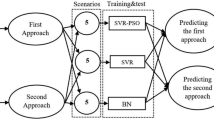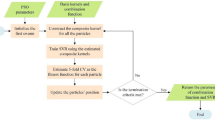Abstract
Quality of surface water is a serious factor affecting human health and ecological systems. Accurate prediction of water quality parameters plays an important role in the management of rivers. Thus, different methods such as (support vector regression) SVR have been employed to predict water quality parameters. This paper applies SVR to predict eight water quality parameters including (sodium (Na+), potassium (K+), magnesium (Mg+2), sulfates (SO4 −2), chloride (Cl−), power of hydrogen (pH), electrical conductivity (EC), and total dissolved solids (TDS)) at the Astane station in Sefidrood River, Iran. To achieve an efficient SVR model, the SVR parameters should be selected carefully. Commonly, various techniques such as trial and error, grid search and metaheuristic algorithms have been applied to estimate these parameters. This study presents a novel tool for estimation of quality parameters by coupling SVR and shuffled frog leaping algorithm (SFLA) . Results of SFLA-SVR compared with genetic programming (GP) as a capable method in water quality prediction. Using SFLA-SVR, average of RMSE for training and testing of six combinations of data sets for all of the water quality parameters improved 57.4 % relative to GP. These results indicate that the new proposed SFLA-SVR tool is more efficient and powerful than GP for determining water quality parameters.



Similar content being viewed by others
References
Afshar A, Shafii M, Haddad OB (2011) Optimizing multi-reservoir operation rules: an improved HBMO approach. J Hydroinf 13:121–139
Aggarwal SK, Goel A, Singh VP (2012) Stage and discharge forecasting by SVM and ANN techniques. Water Resour Manag 26:3705–3724
Aryafar A, Gholami R, Rooki R, Ardejani FD (2012) Heavy metal pollution assessment using support vector machine in the Shur River, Sarcheshmeh copper mine, Iran. Environ Earth Sci 67:1191–1199
Azamathulla HM, Ghani AA (2011) Genetic programming for predicting longitudinal dispersion coefficients in streams. Water Resour Manag 25:1537–1544
Banerjee P, Singh VS, Chatttopadhyay K (2011) Artificial neural network model as a potential alternative for groundwater salinity forecasting. J Hydrol 398:212–220
Chang F-J, Tsai Y-H, Chen P-A (2015) Modeling water quality in an urban river using hydrological factors–Data driven approaches. J Environ Manag 151:87–96
Deka PC (2014) Support vector machine applications in the field of hydrology: a review. Appl Soft Comput 19:372–386
Eusuff MM, Lansey KE (2003) Optimization of water distribution network design using the shuffled frog leaping algorithm. J Water Resour Plan Manag 129:210–225
Fallah-Mehdipour E, Haddad OB, Mariño MA (2012) Real-time operation of reservoir system by genetic programming. Water Resour Manag 26:4091–4103
Fallah-Mehdipour E, Haddad OB, Mariño MA (2013) Developing reservoir operational decision rule by genetic programming. J Hydroinf 15:103–119
Gholami R, Kamkar-Rouhani A, Ardejani FD, Maleki S (2011) Prediction of toxic metals concentration using artificial intelligence techniques. Appl Water Sci 1:125–134
Guven A, Aytek A, Yuce MI, Aksoy H (2008) Genetic programming-based empirical model for daily reference evapotranspiration estimation. Clean–Soil, Air, Water 36:905–912
Han D, Chan L, Zhu N (2007) Flood forecasting using support vector machines. J Hydroinf 9:267–276
Hipni A, El-shafie A, Najah A (2013) Daily forecasting of dam water levels: comparing a support vector machine (SVM) model with adaptive neuro fuzzy inference system (ANFIS). Water Resour Manag 27:3803–3823
Je N, Sutcliffe JV (1970) River flow forecasting through conceptual models part I—A discussion of principles. J Hydrol 10:282–290
Johari A, Habibagahi G, Ghahramani A (2006) Prediction of soil–water characteristic curve using genetic programming. J Geotech Geoenviron 132:661–665
Kisi O, Zounemat-Kermani M (2014) Comparison of two different adaptive neuro-fuzzy inference systems in modelling daily reference evapotranspiration. Water Resour Manag 28:2655–2675
Koza JR (1990) Genetic programming: a paradigm for genetically breeding populations of computer programs to solve problems. Stanford University, Department of Computer Science
Koza JR (1992) Genetic programming: on the programming of computers by means of natural selection. MIT press, Cambridge
Lin J-Y, Cheng C-T, Chau K-W (2006) Using support vector machines for long-term discharge prediction. Hydrol Sci J 51:599–612
Liu M, Lu J (2014) Support vector machine―an alternative to artificial neuron network for water quality forecasting in an agricultural nonpoint source polluted river? Environ Sci Pollut Res 21:11036–11053
Liu S, Tai H, Ding Q (2013) A hybrid approach of support vector regression with genetic algorithm optimization for aquaculture water quality prediction. Math Comput Model 58:458–465
Liu J, Li YP, Huang GH, Nie S (2015) Development of a fuzzy-boundary interval programming method for water quality management under uncertainty. Water Resour Manag 29:1169–1191
Luts J, Ojeda F, Van de Plas R (2010) A tutorial on support vector machine-based methods for classification problems in chemometrics. Anal Chim Acta 665:129–145
Mandal S, Mahapatra SS, Adhikari S, Patel RK (2014) Modeling of arsenic (III) removal by evolutionary genetic programming and least square support vector machine models. Environ Proc 2:145–172
Modaresi F, Araghinejad S (2014) A Comparative assessment of support vector machines, probabilistic neural networks, and K-Nearest neighbor algorithms for water quality classification. Water Resour Manag 28:4095–4111
Mohammadpour R, Shaharuddin S, Chang CK (2015) Prediction of water quality index in constructed wetlands using support vector machine. Environ Sci Pollut Res 22:6208–6219
Muttil N, Chau K-W (2006) Neural network and genetic programming for modelling coastal algal blooms. Int J Environ Pollut 28:223–238
Naddafi K, Honari H, Ahmadi M (2007) Water quality trend analysis for the Karoon River in Iran. Environ Monit Assess 134:305–312
Noori R, Karbassi AR, Moghaddamnia A (2011) Assessment of input variables determination on the SVM model performance using PCA, Gamma test, and forward selection techniques for monthly stream flow prediction. J Hydrol 401:177–189
Noori R, Karbassi A, Ashrafi K (2012) Active and online prediction of BOD5 in river systems using reduced-order support vector machine. Environ Earth Sci 67:141–149
Orouji H, Haddad OB, Fallah-Mehdipour E, Mariño MA (2012) Estimation of Muskingum parameter by meta-heuristic algorithms. Proc ICE-Water Manag 166:315–324
Orouji H, Haddad OB, Fallah-Mehdipour E, Mariño MA (2013a) Extraction of decision alternatives in project management: application of hybrid PSO-SFLA. J Manag Eng 30:50–59
Orouji H, Haddad OB, Fallah-Mehdipour E, Mariño MA (2013a) Modeling of water quality parameters using data-driven models
Pan Y, Jiang J, Wang R (2009) Predicting the auto-ignition temperatures of organic compounds from molecular structure using support vector machine. J Hazard Mater 164:1242–1249
Riahi-Madvar H, Ayyoubzadeh SA, Khadangi E, Ebadzadeh MM (2009) An expert system for predicting longitudinal dispersion coefficient in natural streams by using ANFIS. Expert Syst Appl 36:8589–8596
Shaowu Z, Lianghong WU, Xiaofang Y, Wen Tan (2007) Parameters selection of SVM for function approximation based on differential evolution. In: International Conference on Intelligent Systems and Knowledge Engineering 2007. Atlantis Press
Singh KP, Gupta S (2012) Artificial intelligence based modeling for predicting the disinfection by-products in water. Chemom Intell Lab Syst 114:122–131
Singh KP, Basant A, Malik A, Jain G (2009) Artificial neural network modeling of the river water quality—a case study. Ecol Model 220:888–895
Singh KP, Basant N, Gupta S (2011) Support vector machines in water quality management. Anal Chim Acta 703:152–162
Tan G, Yan J, Gao C, Yang S (2012) Prediction of water quality time series data based on least squares support vector machine. Procedia Eng 31:1194–1199
Üstün B, Melssen WJ, Oudenhuijzen M, Buydens LMC (2005) Determination of optimal support vector regression parameters by genetic algorithms and simplex optimization. Anal Chim Acta 544:292–305
Wang W-C, Chau K-W, Cheng C-T, Qiu L (2009) A comparison of performance of several artificial intelligence methods for forecasting monthly discharge time series. J Hydrol 374:294–306
Wen X, Si J, He Z (2015) Support-vector-machine-based models for modeling daily reference evapotranspiration with limited climatic data in extreme arid regions. Water Resour Manag 29:3195–3209
Yesilnacar MI, Sahinkaya E, Naz M, Ozkaya B (2008) Neural network prediction of nitrate in groundwater of Harran Plain, Turkey. Environ Geol 56:19–25
Acknowledgments
The authors thank National Elites Foundation of Iran for financial support of this research.
Author information
Authors and Affiliations
Corresponding author
Rights and permissions
About this article
Cite this article
Mahmoudi, N., Orouji, H. & Fallah-Mehdipour, E. Integration of Shuffled Frog Leaping Algorithm and Support Vector Regression for Prediction of Water Quality Parameters. Water Resour Manage 30, 2195–2211 (2016). https://doi.org/10.1007/s11269-016-1280-3
Received:
Accepted:
Published:
Issue Date:
DOI: https://doi.org/10.1007/s11269-016-1280-3




